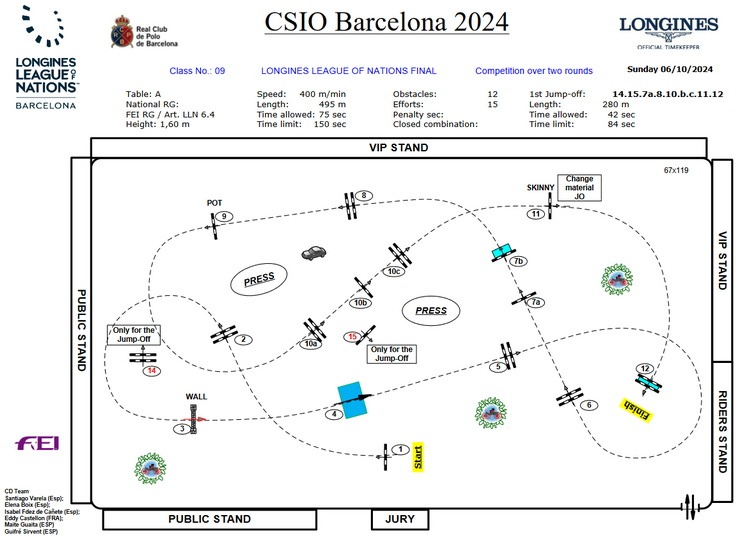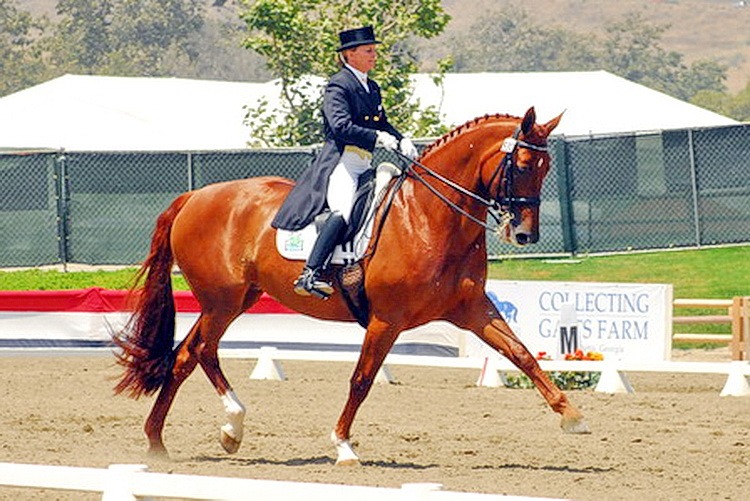
by Nancy Jaffer | Oct 6, 2024
Germany collected the trophy for the first final of the new Longines League of Nations Sunday in Barcelona, but the clever course by Santiago Varela didn’t make it easy.

The Germans had a total of 12 penalties over two rounds. Can you believe the worst score in the second round was two knockdowns from Checker 47, ridden by Christian Kukuk, who just won individual gold at the Paris Olympics? (and where Santi was the designer, with Gregory Bodo of France).
The Netherlands was second on 16 penalties, while the podium was completed by Sweden with 20, which included 0/4 for two rounds from world number one Henrik von Eckermann and King Edward.
The U.S. wound up sixth of nine teams with 28 penalties and no clean rounds, just a bunch of 4 fault trips and one 8 fault round.
Coach Robert Ridland called the team of Alex Matz (Ikigai/4), Lucy Davis Kennedy (Ben 431/4 and 4), Aaron Vale (Carissimo 25/ 4 and 4) Spencer Smith (Keeneland/4 and 8) “relatively inexperienced.”
“It was one of those days that we fell victim to four-fault rounds,”he said.
“Everyone put in solid rounds and dug deep to deliver a good result. Our primary target this year was the Olympic Games, where we won team silver. None of the team medalists from Paris were on the podium here (gold medal Britain did not compete in the final), which shows just how many talented nations there are in jumping and that everything has to go your way on the day.”
click here for results
by Nancy Jaffer | Sep 19, 2024
In the wake of the announcement that the last three shows of the season at Princeton Show Jumping have been cancelled, the Princeton Equestrian League Year-End Awards Party has been rescheduled. It will be held Oct. 5 at Hunter Farms, 1315 The Great Road, Princeton, N.J.
The party begins at 3 p.m., the awards will be at 4:30 p.m.
The party is free for all 2024 PEL members, trainers, and their families. Princeton will supply pizza and drinks; those attending should feel free to bring desserts or other items to share. Click on this link to RSVP by Oct. 1.

by Nancy Jaffer | Oct 1, 2024
It was a change of pace for me recently when, instead of asking the questions, I became the one being interviewed. I was a guest on this week’s episode (number 754) of The Dressage Radio Show, the official podcast of the U.S. Dressage Federation, to discuss “Riding Through,” a book I wrote with Olympian Debbie McDonald that was published in 2006.

Debbie McDonald and Brentina, 2008.
The “how-to” dressage tips it details are timeless, which is why it has been chosen as the first offering of the U.S. Dressage Federation Book Club, a benefit for the federation’s members. The club will have a discussion about the book in a webinar Oct. 8 at 8 p.m. Eastern time. Evelyn Lancione, USDF’s member education coordinator, is in charge of the webinar, during which members will discuss the book and ask me questions about it. To register for the webinar, click on this link. To submit a question, address it to bookclub@usdf.org
The podcast was hosted by Reese Koffler-Stanfield and Megan McIssac. Here are links to the episode on the Horse Radio Network and on Apple Podcasts. The entire 47-minute episode of the podcast is interesting, since part of it deals with the Paralympics. However, if you want to go directly to my segment, you can fast forward on your podcast app to the 30-minutes-30-seconds mark, or you can just click on this link to listen to my segment of the podcast on YouTube starting at that time stamp. To hear what Evelyn had to say, go to the 23-minute mark.

by Nancy Jaffer | Sep 29, 2024
A rider who was equally at home on jumpers and hunters, Patty Stovel can best be described simply as an incredibly hard worker who was a great horsewoman and teacher. She passed away Sunday at 67 after a long illness.
Trainer Otis Brown, a long-time associate of Patty’s, posted on social media: “So hard to say goodbye. I will forever cherish our 40 years as friends and business partners. From World Equestrian Games to six times champion of the International Hunter Futurity, numerous national champions and Grand Prix wins, I am forever grateful. Thanks for the memories, Patty.”
Patty grew up in Connecticut at her family’s Merrie-Land Stables, learning to ride under the guidance of her mother, Barbara Johnson, who instilled a love of horses in all her children when she built her business starting in the early 1960s. By the time Patty was 16, she was running her own little barn down the road. A working student for George Morris as a teenager, she finished second in the AHSA Medal Finals on her home-trained Brownstone.
Patty went on to work for Otis Brown in Tennessee. Among the top hunters she rode was Nashville Gent, who became the AHSA’s 1986 Regular Working Hunter horse of the year. Her most memorable jumpers included Volan and Frisco Kid. But it was Mont Cenis, the brilliant athlete she started riding when she went out on her own in 1990, who was her horse of a lifetime.
Patty rode him through the trials for the 1994 World Equestrian Games in the Hague, courageously meeting the challenge despite a broken wrist and collarbone to make the team. Patty finished as the best of the U.S. squad, in thirteenth place.
Among her many other accomplishments, she rode Frascati to the American Horse Shows Association Working Hunter Horse of the Year title in 1999 and 2000. She also guided Chippen in Style to the 2009 American Quarter Horse Association World Championship in Progressive Working Hunter.

Patty Stovel
Her daughter, U.S. Equestrian Federation National Breeds and Disciplines Breed and Program Manager Lexie Cerys Stovel, said on Facebook, “She lived and loved the horses for her whole life. She accomplished so much, from being the highest placed U.S. rider at the (1994) World Equestrian Games, to winning the American Gold Cup, to winning Regular Working Hunter Horse of the Year two years in a row.
“She was also the best mom. The number of animals she surprised me with over the years is uncountable. She is the reason I am the animal lover I am.”
In an interview, Lexie said that her mother was diagnosed with cancer in 2000, but had a “really good quality of life until the last eight months,” continuing her pursuits almost as normal for several years.
“She felt she was really blessed to have that time,” said Lexie, but noted that even when her mother was really sick, she showed in the Baby Green Hunters in June at the Kentucky Horse Park.
“She never wanted to not be doing it. She was committed to horses and the industry. It wasn’t something she was able to give up. She fought for over four years. She was always so strong-willed,” observed Lexie.
In addition to Lexie and her brothers, Robert Johnson and Donald Johnson, Patty is survived by her ex-husband, Ken Stovel. A celebration of her life is being planned for Ocala this winter.
Those wishing to make a donation in her memory may contact the Pancreatic Action Network at
www.pancan.org or
Paws4thecause.com, an animal rescue from which she got quite a few dogs.
by Nancy Jaffer | Sep 29, 2024
Olympic eventer Liz Halliday is now working on her recovery from traumatic brain injury at the Shirley Ryan AbilityLab in Chicago. The facility is rated as the number one rehabilitation hospital in the U.S.
Liz was operated on to relieve pressure on her brain after her horse fell during the American Eventing Championships a month ago at the Kentucky Horse Park. Her mount was not injured.
The rider is being treated by a team of specialists “dedicated to empowering her as she moves forward on the path to healing. With Shirley Ryan’s innovative therapies and unwavering support, Liz is working hard every day to conquer new challenges,” according to a statement from her friends and family.
Shirley Ryan is the first “translational” research hospital, where clinicians, scientists, innovators and technologists work together in the same location, applying (“translating”) research in real time.
Liz’s team thanked the staff at the University of Kentucky Albert B. Chandler Hospital, where Liz was treated after the accident.
“Their exceptional care and dedication during Liz’s stay have been instrumental in her recovery, and we will forever be thankful for their expertise and compassion,” the statement said, while thanking everyone who has sent messages of encouragement to Liz..

by Nancy Jaffer | Sep 27, 2024
The Longines FEI Jumping World Cup™ qualifier in Las Vegas, part of the North American League (NAL) for the 2024/2025 season will not be replaced due to the short time frame to organize a high-quality replacement in November, it was announced Friday.
Additionally, commercial and broadcast commitments already in place would have posed significant challenges, and adding a replacement qualifier would have created difficulties in maintaining consistent broadcast coverage and partnership agreements.
The 2024/25 season will only have seven NAL qualifiers, but those seeking to qualify for the April finals in Switzerland will still use four scores to make the cut.
Todd Hinde, FEI Director of Jumping said, “We believe this decision is essential to maintaining the competitive integrity of the league. We look forward to the upcoming bidding process and to working closely with organizers to ensure that future events meet the high standards of the Longines FEI Jumping World Cup™.”
Blenheim EquiSports, which got the rights for the qualifier through 2027, called off the competition due to “unforeseen circumstances.” When asked for specifics, Robert Ridland, president of Blenheim, said “I cannot comment at this time.”
Meanwhile, cancellation of the Vegas qualifier led to new possibilities for the Marshall+Sterling Insurance/USHJA National Championships, which had been scheduled to run with the Cup qualifier at the South Point Hotel and Casino.
That show will be a stand-alone produced by the Desert International Horse Park, led by Steve Hankin. Pat Boyle will continue as show manager.
Explaining his decision to become involved with the championships, Steve said, “We’re excited to put on a great event in Vegas and continue to help build up the sport. We’re two months out from the event and we want it to be successful. We’re going to put in a lot of energy and focus on the event and the sport and that’s what we care about.”

Showing in Vegas is a highlight of the year for those qualifying for the USHJA Championships.
Discussing working with Steve and Desert International Horse Park, USHJA President Britt McCormick commented, “Their expertise, coupled with Pat Boyle’s continued leadership, will elevate this year’s championships, allowing us to bring more opportunities to our competitors.”
Those include enabling the Nov. 11-17 fixture to accept additional participants and showcase key competitions in slots previously reserved for the international-level show jumping. The Western Conference Equitation Finals will be the highlight on Saturday night, while the IHSA/USHJA 3’3″ Hunter Seat Medal Final West is the feature for Sunday.

Conor Swail won the Longines FEI qualifier in Las Vegas last year. (Andrew Ryback Photography)
Ridland guided the Olympic show jumping team in Paris to its third consecutive silver medal under his direction as chef d’equipe. His contract for that position is up for renewal at the end of this year; such contracts in all the Olympic disciplines run with the Games quadrennium.
It has been a rough year for Blenheim EquiSports, which lost some dates for its shows due to water quality issues involving the Rancho Mission Viejo Riding Park it runs south of Los Angeles. For previous stories about the topic, click here and here.








